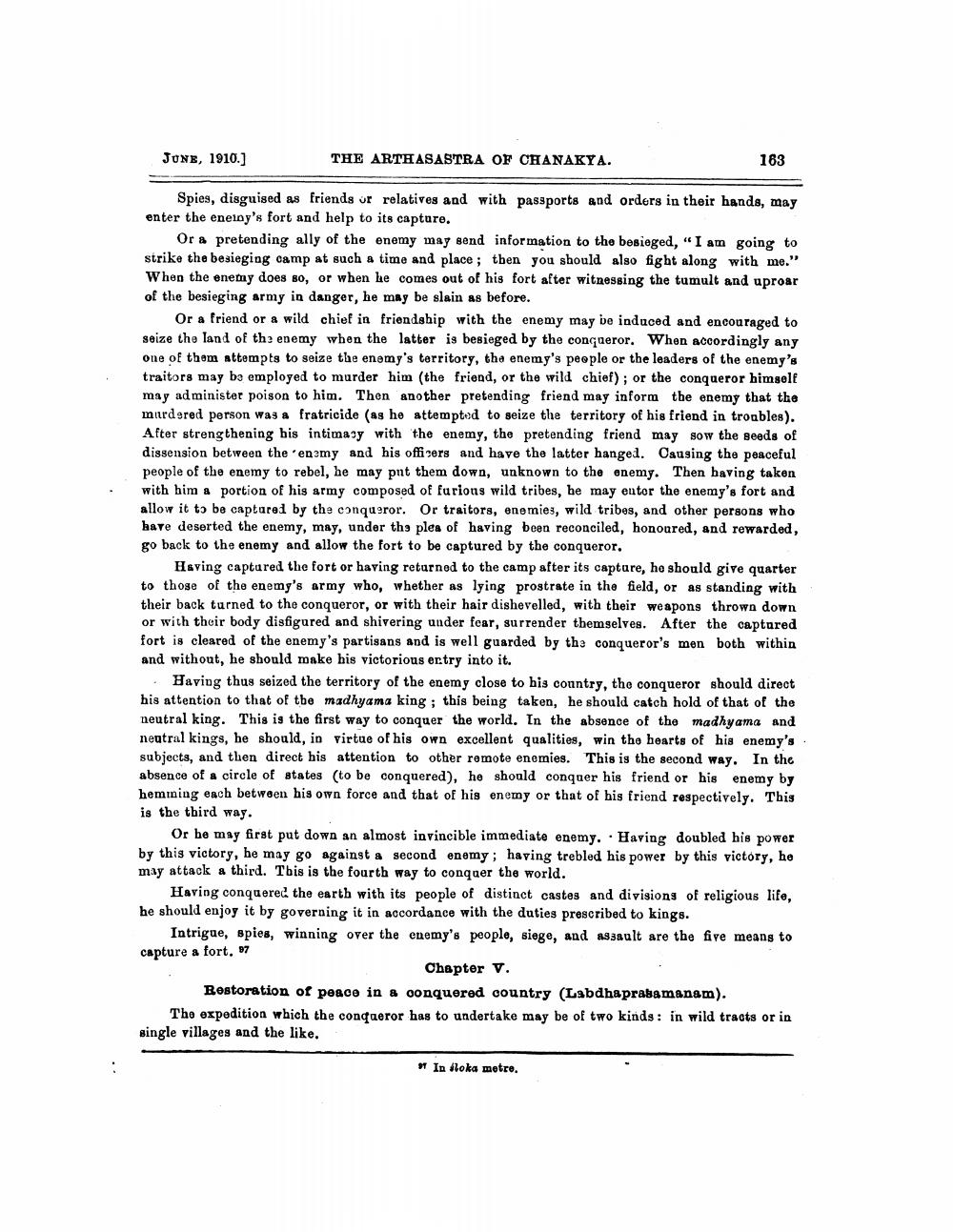________________
JUNE, 1910.)
THE ARTHASASTRA OF CHANAKYA.
163
Spies, disguised as friends or relatives and with passports and orders in their hands, may enter the enemy's fort and help to its capture.
Or a pretending ally of the enemy may send information to the besieged, "I am going to strike the besieging camp at such a time and place; then you should also fight along with me." When the enemy does so, or when he comes out of his fort after witnessing the tumult and uproar of the besieging army in danger, he may be slain as before.
Or a friend or a wild chief in friendship with the enemy may be induced and encouraged to seize the land of th: enemy when the latter is besieged by the conqueror. When accordingly any one of them attempts to seize the enemy's territory, the enemy's people or the leaders of the enemy's traitors may be employed to murder him (the friend, or the wild chief); or the conqueror himself may administer poison to him. Then another pretending friend may inform the enemy that the murdered person was a fratricide (as he attempted to seize the territory of his friend in troubles). After strengthening bis intimacy with the enemy, the pretending friend may now the seeds of dissension between the enemy and his officers and have the latter hangel. Causing the peaceful people of the enemy to rebel, he may put them down, unknown to the enemy. Then having taken with him a portion of his army composed of furions wild tribes, he may enter the enemy's fort and allow it to be captured by the conqueror. Or traitors, enemies, wild tribes, and other persons who have deserted the enemy, may, under the plea of having been reconciled, honoured, and rewarded, go back to the enemy and allow the fort to be captured by the conqueror.
Having captured the fort or having returned to the camp after its capture, he should give quarter to those of the enemy's army who, whether as lying prostrate in the field, or as standing with their back turned to the conqueror, or with their hair dishevelled, with their weapons thrown down or with their body disfigured and shivering under fear, surrender themselves. After the captured fort is cleared of the enemy's partisans and is well guarded by the conqueror's men both within and without, he should make his victorious ertry into it.
Having thus seized the territory of the enemy close to his country, the conqueror should direct his attention to that of the madhyama king; this being taken, he should catch hold of that of the neutral king. This is the first way to conquer the world. In the absence of the madhyama and neatral kings, he should, in virtue of his own excellent qualities, win the hearts of his enemy's subjects, and then direct his attention to other remote enemies. This is the second way. In the absence of a circle of states to be conquered), he should conquer his friend or his enemy by hemming each between his own force and that of his enemy or that of his friend respectively. This is the third way.
Or he may first put down an almost invincible immediate enemy. Having doubled his power by this victory, he may go against a second enemy; having trebled his power by this victory, he may attack a third. This is the fourth way to conquer the world.
Having conquered the earth with its people of distinct castes and divisions of religious life, he should enjoy it by governing it in accordance with the duties prescribed to kings.
Intrigue, spies, winning over the enemy's people, siege, and assault are the five means to capture a fort. 97
Chapter v. Restoration of peace in a conquered country (Labdhaprabamanam). The expedition which the conqueror has to undertake may be of two kinds : in wild tracts or in single villages and the like.
» In sloka metre.




